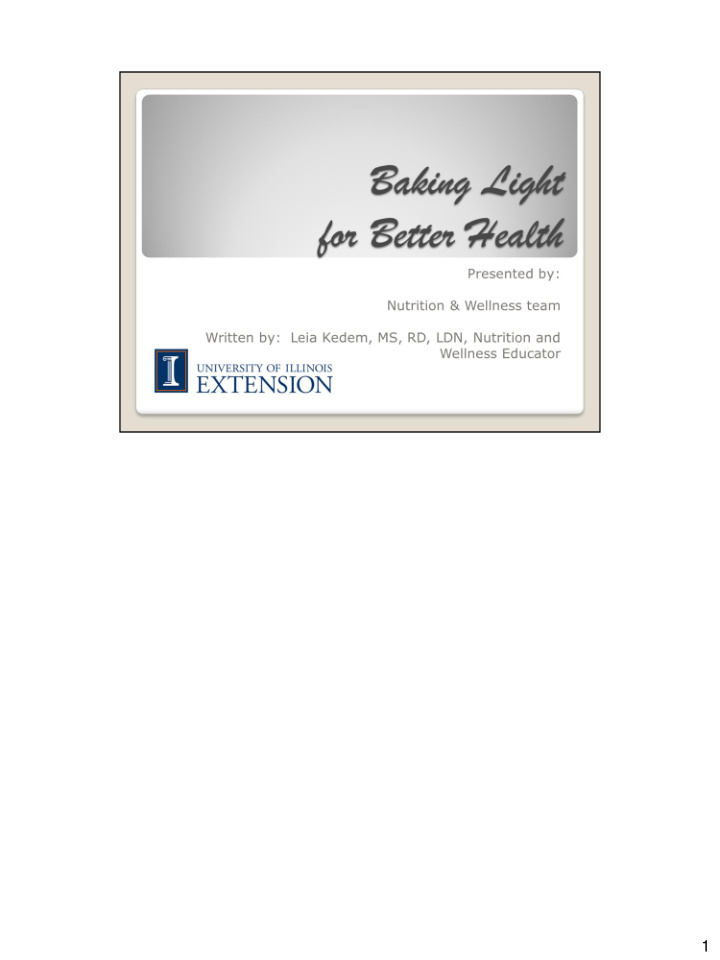



1
Americans love dessert – so telling people not to eat them for good health is not the answer. The answer is make desserts a sometime food and choose desserts that add to the overall meal plan and provide more than just calories. 2
Mini or small “bite - size” desserts are popular - cake pops, cupcakes, etc. Join the trend. In the 3-bite “rule” use the first bite to just get a taste, use the second bite to notice flavors and textures, and use the third – and final – bite to savor. If you have any dessert left, it gets thrown out. Research says we get all the flavors, textures and sensations of a food in first 3 bites. After that, our taste sensations are used to the dessert and you do not get as much enjoyment after, such as at bite 15. You can also modify recipes to reduce fat and sugar while increasing fiber and other nutrients. 3
There are three ways to improve the nutrition of the desserts you eat: sugar, fat, and salt. 4
Fats in baking make products tender, add flavor, and add moisture. However, since fats are very high in calories, look at reducing the amount. You can reduce by a third and not majorly affect the quality of the final dessert. Note that shortening and some margarines contains large amounts of trans fats and can raise blood cholesterol numbers. Consider using other fats in your shortening- containing recipe instead. If using margarine, look for trans -fat free brands. 5
Fruit Puree • Applesauce – substitute for equal amounts of fat – product will be very moist, may need to reduce liquid in recipe • Mashed bananas -- substitute for equal amounts of fat – gives distinct flavor • Pureed prunes -- substitute for equal amounts of fat – product will be very dry, so add moisture in form of prune juice, milk or water – gives a dark color Veggie Puree • Pureed pumpkin -- substitute for equal amounts of fat, gives distinct flavor and color • Grated zucchini -- substitute for equal amounts of fat – works best in quick breads • Pureed tofu -- substitute for only 1/2 of fat – gives beany flavor 6
Instead of using whole-fat milk, sour cream, cheese, etc., try reduce-fat versions instead. Fat-free often does give a good quality product, since fats provide important features in baking. 7
Coconut, nuts, chocolate chips, and other mix-ins add more fat. Try these tips to reduce the amount you use while still getting the crunch and flavor you want. 8
The chemical properties of calorie-free sweeteners and sugar substitutes are not the same as table sugar and other calorie-containing sugars. They will not brown or taste the same. If using, find a recipe that has been tested with them. 9
Be aware, sugar is sugar to your body. Honey is not a “healthier” sugar, nor is agave. Other sweeteners besides table sugar (honey, molasses, etc.) have unique flavors that table sugar does not. However, they are still sugar. 10
Do not reduce or remove salt in yeast-bread recipes. The salt is needed to help control the growth of yeast and help in the structure of the bread. Add more herbs and spices when reducing salt. 11
12
13
Trying to make more than one change at a time will often make a product that is less than desirable in taste and quality. 14
This brownie recipe was modified. Name the changes you see. Hint: add applesauce, reduce margarine, use egg whites, reduced salt, reduce nuts 15
Here are the nutritionals. Name the changes you see. Hint: lower calories, lower fat, lower sodium Overall savings: 40 calories, 5g fat, and 70mg sodium per serving 16
Hints: use whole-wheat pasta, use reduced-fat sausage or lean ground meat, use reduced-sodium tomatoes, use plain spinach instead of creamed, use reduced-fat cream cheese 17
Hints: Crust: Use chocolate graham crackers instead of cream-fill cookies, reduce butter, remove crust entirely or sprinkle crusted cookies on top (no butter) Filling: reduced-fat cream cheese, reduce sugar by half, reduced-fat whipped topping, fewer peanut butter cups, specify for fat-free or 1% milk, try sugar-free pudding mix 18
19
Recommend
More recommend